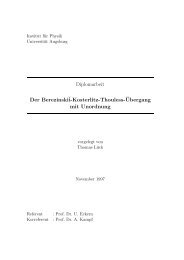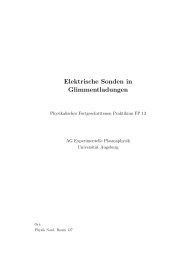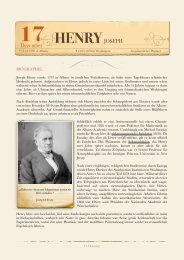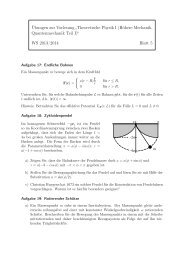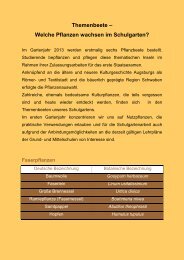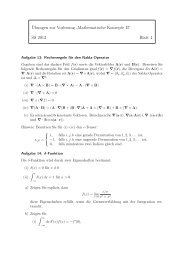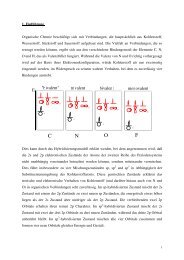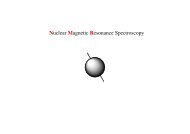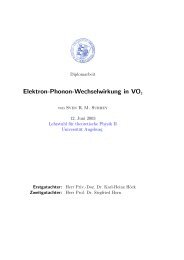PhD Thesis - Universität Augsburg
PhD Thesis - Universität Augsburg
PhD Thesis - Universität Augsburg
You also want an ePaper? Increase the reach of your titles
YUMPU automatically turns print PDFs into web optimized ePapers that Google loves.
32 2. Density-Matrix Renormalization Group<br />
Here we only used the orthonormality of the site local basis {|s j 〉}.<br />
Equations (2.25) and (2.26) can be used to find a matrix representation of any local<br />
operator, that acts on some site j < i in the basis B(L, i).<br />
It remains to find a matrix representation of the product of two local operators ˆQ k and<br />
Ô j , acting on the different sites k and j (k < j), respectively, e in the basis B(L, l). For this<br />
we start with the L(k)-representation Q L(k) of ˆQ k (2.25) and using (2.26) iteratively obtain<br />
its L(j − 1)-representation. Then using (2.8) we write the product of Q L(j−1) and matrix<br />
representation of Ôj (O j ) in the basis B(L, j) and hence obtain the L(j)-representation of<br />
ˆQ k Ô j ( ˆQ k Ô j ) L(j)<br />
= 〈α<br />
α j|( ′ ˆQ k Ô j )|α ′<br />
j ,α j 〉<br />
j<br />
⎛<br />
⎞ ⎛<br />
⎞<br />
∑<br />
= ⎝〈α j−1|〈s ′ ′ j| A ∗ j(s ′ j) α ′ ⎠<br />
j−1 ,α ′ ( ˆQ k Ô j ) ⎝ ∑<br />
A<br />
j<br />
j (s j ) αj−1 ,α j<br />
|α j−1 〉|s j 〉 ⎠<br />
α ′ j−1 ,α′ j<br />
α j−1 ,α j<br />
⎛<br />
⎞<br />
⎛<br />
⎞<br />
= ⎝ ∑<br />
A ∗ j (s′ j ) ⎠<br />
α ′ Q L(j−1)<br />
j−1 ,α′ j α ′<br />
α ′ j−1 j−1O j ⎝ ∑<br />
A ,α s ′ j ,s j (s j ) αj−1<br />
⎠<br />
,α<br />
j<br />
j<br />
j−1 ,α′ j<br />
α j−1 ,α j<br />
∑<br />
= A ∗ j (s′ j ) α ′ A j−1 ,α′ j j (s j ) α j−1 ,α j<br />
Q L(j−1)<br />
α ′ j−1 j−1O j , (2.27a)<br />
,α s ′ j ,s j<br />
α ′ j−1 ,α j−1,s ′ j ,s j<br />
or in matrix notation<br />
( ˆQ k Ô j ) L(j) = ∑ s ′ j ,s j<br />
A † j (s′ j )QL(j−1) A j (s j ) O j s ′ j ,s j. (2.27b)<br />
Finally, once more using (2.26) iteratively, from (2.27) we obtain its L(l)-representation.<br />
This can be easily generalized for the product of more than two operators each acting on<br />
a different site, e.g.,<br />
Ô ν = Ô1 ν Ô2 ν · · ·Ôl ν . (2.28)<br />
O L(l) (2.24) is then constructed by summing up L(l)-representations Oν<br />
L(l) of Ô ν . Note<br />
that we can take the sum but not the product of operators in the same L(l)-representation;<br />
since B(L, l) is the basis of the block subspace and not the complete one,<br />
( ˆQÔ)L(l) α ′ l ,α l<br />
= 〈α ′ l |( ˆQÔ)|α l 〉 ≠ ∑ α ′′<br />
l<br />
〈α l ′ ′′<br />
| ˆQ|α l 〉〈α′′ l |Ô|α l 〉 = [OL(l) Q L(l) ] α ′<br />
l ,α l<br />
. (2.29)<br />
As mentioned at the beginning, typically most of Ôν j in Ôν are just identity operators Î,<br />
corresponding to identity matrices in the site-local basis. In case of fermionic operators, due<br />
to the anticommutation relations, one should take care about “-” signs where it is necessary.<br />
e For k = j we take the product in the local basis of the site k and obtain a new local operator.



